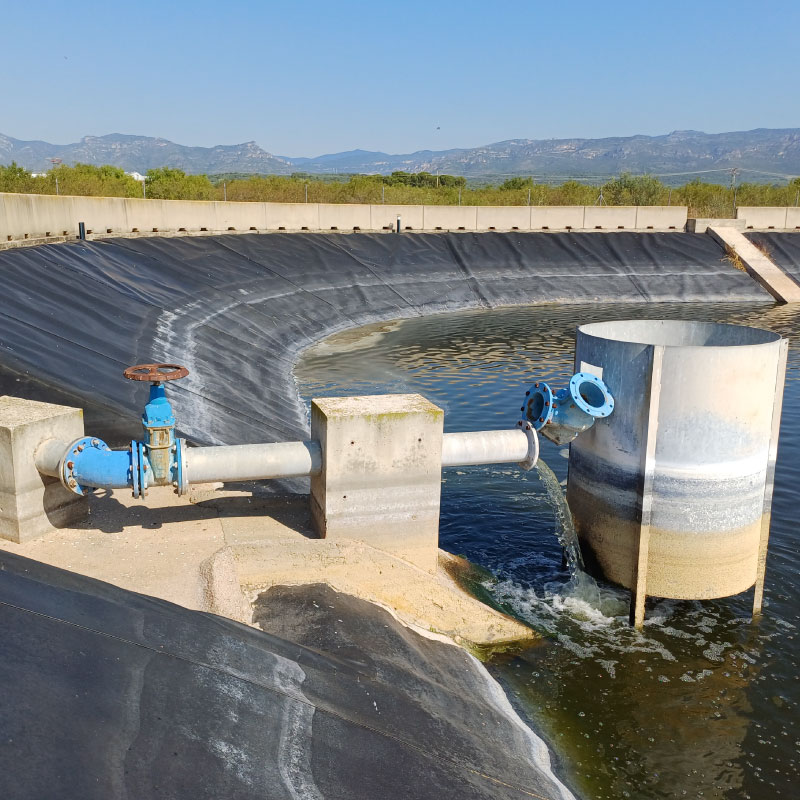Innovation and sustainability in water resources management


In a global context marked by climate change and increasing water scarcity, wastewater regeneration has become an essential strategy for the sustainable management of water resources.
This innovative practice makes it possible to transform what was previously considered waste into a valuable resource, contributing significantly to the circular economy and the preservation of the environment.
In a global context marked by climate change and increasing water scarcity, wastewater regeneration has become an essential strategy for the sustainable management of water resources.
This innovative practice makes it possible to transform what was previously considered waste into a valuable resource, contributing significantly to the circular economy and the preservation of the environment.

WATER REGENERATION
Benefits of water regeneration

This innovative approach to water resource management presents a number of key benefits that contribute significantly to the sustainability and resilience of our water systems. From conserving freshwater sources to fostering more sustainable urban development, water reclamation is positioned as a critical tool to address current and future water challenges.
Below, we explore the main benefits that this practice brings to our water management and the environment in general.
- Water Resource Conservation: Reduces pressure on freshwater sources by providing an alternative source of water.
- Reduction of polluting discharges: Minimizes the discharge of treated wastewater into natural water bodies.
- Improved water resilience: Increases water availability in regions prone to scarcity.
- Reduction of the water footprint: It allows industries and agriculture to minimize their impact on local water resources.
- Promotion of sustainable urban development: Promotes water self-sufficiency in urban environments.
Discover how water regeneration can transform your water management
This innovative approach to water resource management presents a number of key benefits that contribute significantly to the sustainability and resilience of our water systems. From conserving freshwater sources to fostering more sustainable urban development, water reclamation is positioned as a critical tool to address current and future water challenges.
Below, we explore the main benefits that this practice brings to our water management and the environment in general.
- Water Resource Conservation: Reduces pressure on freshwater sources by providing an alternative source of water.
- Reduction of polluting discharges: Minimizes the discharge of treated wastewater into natural water bodies.
- Improved water resilience: Increases water availability in regions prone to scarcity.
- Reduction of the water footprint: It allows industries and agriculture to minimize their impact on local water resources.
- Promotion of sustainable urban development: Promotes water self-sufficiency in urban environments.
Discover how water regeneration can transform your water management
Applications and technologies in water regeneration
Reclaimed water offers a wide range of applications that contribute significantly to water sustainability. In agriculture and urban areas, this water is used effectively for the irrigation of crops and green spaces, reducing the demand for drinking water for these purposes. The industry also benefits, incorporating reclaimed water into its production processes and cooling systems, which reduces its water footprint.
In addition, reclaimed water plays a crucial role in recharging aquifers, helping to maintain groundwater balance. In the urban environment, it is used for cleaning streets and vehicles, as well as for ornamental uses in artificial fountains and lakes, improving the quality of life in cities without compromising drinking water resources.
To achieve these various uses, water regeneration relies on a constantly evolving set of advanced technologies. Ultrafiltration and reverse osmosis are fundamental processes that allow contaminants to be removed at the molecular level, guaranteeing a high quality of the treated water. UV disinfection provides an additional barrier against pathogens without the use of chemicals. Advanced biological treatments and oxidation processes represent innovative solutions to address emerging contaminants and improve treatment efficiency.
Challenges in the implementation of regeneration projects
Despite its many benefits, the implementation of water reclamation projects is not without its challenges. The costs associated with implementing and operating these technologies can be significant, requiring careful planning and innovative financing strategies. Public acceptance plays a crucial role, and it is necessary to address perceptions of risk and build confidence in the safety of reclaimed water.
The regulatory framework and regulatory compliance represent another critical aspect, as legislation must evolve to adapt to these new water reuse practices, ensuring the protection of public health and the environment. In addition, it is important to consider the energy requirements and carbon footprint associated with the regeneration processes, always looking for options that minimise the environmental impact.
Finally, the management of treatment by-products, such as sewage sludge, requires special attention to ensure their disposal or reuse in a sustainable manner. Addressing these challenges holistically is critical to maximizing the benefits of water regeneration and moving towards a more sustainable water future.
SOCOTEC's role in water reclamation
At SOCOTEC Spain, we recognise the crucial importance of water regeneration for a sustainable future, and that is why we include our portfolio of services under the brand GREEN TRUST by SOCOTEC. Our expertise covers the entire water reuse project cycle, from the design and optimization of treatment processes to the implementation of reclaimed water transport and distribution systems.
We offer specialized services including:
- Design and optimization of water regeneration plants
- Evaluation and selection of advanced treatment technologies
- Technical and regulatory advice for regeneration projects
- Reclaimed water quality monitoring and control
- Feasibility studies and environmental impact assessment
Tecnología
Se requiere una adaptación de muchas de las actuales depuradoras para alcanzar los niveles de calidad exigidos por la normativa, introduciendo tratamientos terciarios como la ultrafiltración, la desinfección por UV u ozono y sistemas de control en continuo que garantice una calidad estable del efluente. A ello se suma la necesidad de un estricto control microbiológico y de planes de gestión del riesgo, que aseguren la eliminación eficaz de patógenos y minimicen los riesgos sanitarios.
Otro reto creciente es la presencia de contaminantes emergentes —microplásticos, fármacos o PFAS— que requieren procesos cuaternarios de oxidación avanzada, adsorción, ósmosis inversa u otros, para su eliminación.
Financiación
Estos proyectos afrontan importantes desafíos económicos derivados de los altos costes de inversión y operación asociados a los sistemas de tratamiento, monitorización y distribución. La ampliación de las instalaciones existentes y la construcción de redes específicas para agua regenerada requieren elevadas inversiones iniciales e incrementos notables de OPEX, difíciles de asumir sin apoyo público o modelos de financiación compartida.
En ocasiones, el precio del agua regenerada no cubre los costes reales de producción, especialmente en el sector agrícola, donde la rentabilidad depende de tarifas competitivas, por lo que los retornos económicos de los proyectos a largo plazo son a menudo un problema.
En general, la falta de mecanismos estables de financiación, incentivos o marcos tarifarios claros limita la expansión de estas iniciativas, por lo que resulta esencial avanzar hacia esquemas que combinen eficiencia económica, apoyo institucional y valoración del recurso regenerado como parte de la economía circular del agua.
Normativa
La implantación de proyectos de regeneración de agua se enfrenta a la habitual complejidad administrativa, debida a la intervención de múltiples organismos con competencias en agua, sanidad, medio ambiente y agricultura. Esta fragmentación provoca procedimientos largos y heterogéneos, que retrasan la tramitación de autorizaciones y la puesta en marcha de las instalaciones.
El marco normativo, reforzado por el Real Decreto 1085/2024 que amplía el Reglamento UE 2020/741, introduce requisitos más exigentes en materia de calidad, control y gestión del riesgo, lo que a priori es positivo, pero en la práctica se convierte en un incremento de carga documental. Además, persisten dudas sobre la distribución de responsabilidades entre productores, distribuidores y usuarios del agua regenerada, especialmente ante posibles incidencias sanitarias o ambientales.
Superar estos obstáculos requiere mayor coordinación institucional, simplificación de trámites y la elaboración de guías técnicas comunes que faciliten la aplicación uniforme de la normativa de un modo armonizado en todo el territorio europeo, lo cual facilita la transferencia de conocimiento, de tecnología y el crecimiento de un mercado que debe ser sostenible económicamente.
Social
Si bien existe hoy en día una percepción general positiva sobre la regeneración de agua porque se asocia a una cultura de sostenibilidad y de ahorro hídrico, la creciente polarización informativa que alcanza a la población, combinada con la facilidad de distorsión de los mensajes técnicos, puede generar resistencia social hacia el uso de aguas regeneradas, especialmente cuando existe contacto directo con personas o productos alimentarios. Este “factor psicológico” puede constituir una barrera no menor para la expansión de la reutilización.
Estos desafíos que hemos apuntado son abordables a partir de un contexto regulatorio eficaz, pero estamos en una fase relativamente preliminar y no podemos predecir la viabilidad a largo plazo de este uso del agua. Es necesario asegurar la viabilidad económica, clarificar responsabilidades legales y promover o mantener la aceptación pública. Sólo mediante un enfoque coordinado y holístico se podrá consolidar la reutilización del agua como un recurso seguro, eficiente y socialmente aceptado.
Ambiental
Uno de los principales desafíos es equilibrar la producción continua de agua regenerada con una demanda estacional, especialmente en el ámbito agrícola, lo que exige disponer de infraestructuras de almacenamiento o sistemas de recarga de acuíferos que permitan una gestión más flexible.
Applications and technologies in water regeneration
Reclaimed water offers a wide range of applications that contribute significantly to water sustainability. In agriculture and urban areas, this water is used effectively for the irrigation of crops and green spaces, reducing the demand for drinking water for these purposes. The industry also benefits, incorporating reclaimed water into its production processes and cooling systems, which reduces its water footprint.
In addition, reclaimed water plays a crucial role in recharging aquifers, helping to maintain groundwater balance. In the urban environment, it is used for cleaning streets and vehicles, as well as for ornamental uses in artificial fountains and lakes, improving the quality of life in cities without compromising drinking water resources.
To achieve these various uses, water regeneration relies on a constantly evolving set of advanced technologies. Ultrafiltration and reverse osmosis are fundamental processes that allow contaminants to be removed at the molecular level, guaranteeing a high quality of the treated water. UV disinfection provides an additional barrier against pathogens without the use of chemicals. Advanced biological treatments and oxidation processes represent innovative solutions to address emerging contaminants and improve treatment efficiency.
Challenges in the implementation of regeneration projects
Despite its many benefits, the implementation of water reclamation projects is not without its challenges. The costs associated with implementing and operating these technologies can be significant, requiring careful planning and innovative financing strategies. Public acceptance plays a crucial role, and it is necessary to address perceptions of risk and build confidence in the safety of reclaimed water.
The regulatory framework and regulatory compliance represent another critical aspect, as legislation must evolve to adapt to these new water reuse practices, ensuring the protection of public health and the environment. In addition, it is important to consider the energy requirements and carbon footprint associated with the regeneration processes, always looking for options that minimise the environmental impact.
Finally, the management of treatment by-products, such as sewage sludge, requires special attention to ensure their disposal or reuse in a sustainable manner. Addressing these challenges holistically is critical to maximizing the benefits of water regeneration and moving towards a more sustainable water future.
SOCOTEC's role in water reclamation
At SOCOTEC Spain, we recognise the crucial importance of water regeneration for a sustainable future, and that is why we include our portfolio of services under the brand GREEN TRUST by SOCOTEC. Our expertise covers the entire water reuse project cycle, from the design and optimization of treatment processes to the implementation of reclaimed water transport and distribution systems.
We offer specialized services including:
- Design and optimization of water regeneration plants
- Evaluation and selection of advanced treatment technologies
- Technical and regulatory advice for regeneration projects
- Reclaimed water quality monitoring and control
- Feasibility studies and environmental impact assessment
Discover how water regeneration can transform your water management

You might also be interested...






